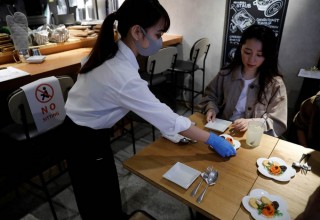Loading
Search
▼ As Japan Reopens, A Hospital Grapples With Coronavirus Aftermath
- Category:Other
Doctors in white coats and blue scrubs sat around a conference room table in June, looking up at a colorful slide projected on the wall.
"How is anyone supposed to memorize this?" a doctor sitting in the back asked as Yoshihiro Masui, the director of Yokohama City Seibu Hospital's critical care center, checked the slides.
The presentation, full of color-coded flow charts, showed dozens of new safety protocols for everything from routine surgeries to dialysis.
Weeks earlier, Seibu had been the site of one of the worst hospital coronavirus outbreaks in Japan, with some 80 people testing positive for COVID-19, including 43 staff members. By the time the hospital contained the spread, 13 elderly patients had died.
For most of May, the 500-bed hospital, in a port city 30km south of Tokyo, had sat empty. After the outbreak, it halted nearly all outpatient services. Doctors and nurses were required to spend two weeks at home, monitoring for symptoms before they could return to work.
Now, as the country emerges from a state of emergency, hospitals like Seibu face the prospect of operating in the shadow of a virus with no treatment or cure.
"We can never have an outbreak again like the one we experienced," said Masui, an emergency doctor who has been charged with the hospital's coronavirus response. "What we learned is that this can truly happen anywhere." ‘NEW NORMAL’
Doctors and nurses at Seibu were among the first to mobilize for the pandemic in Japan, accepting sick passengers from the Diamond Princess cruise ship in February.
After treating dozens of coronavirus patients, a man with no fever and no other obvious symptoms was carried into the emergency room in early April. The man was kept in a room with another patient before he was discharged to another facility. By the time the staff learned in late April the man had the virus, it had already spread to other wings of the hospital.
Masui says he felt responsible for the outbreak.
"I pushed the hospital to take in suspected coronavirus patients, knowing other hospitals were turning them away," he said during a rare break between his rounds. "I was the one convincing the head of the hospital to take these patients in."
More than 18,000 people have tested positive for the virus in Japan. The number of new coronavirus cases have fallen since mid-April and with 971 deaths, the country has so far managed to dodge the kind of catastrophic death toll seen elsewhere.
But for medical workers, new outbreaks remain a constant threat. The Mainichi newspaper found that 99 medical facilities have reported infections.
New safety precautions to guard against the coronavirus can make life-saving measures more difficult.
Kentaro Sato, a 29-year old doctor in the emergency room, spent two weeks at home after he rushed to resuscitate a child who suddenly went into cardiac arrest.
"I knew I had to put on a gown beforehand but I thought, this is a kid, and I have to do something to help," said Sato, who learned later the patient had a fever and was suspected of having COVID-19. Before the test came back negative, Sato spent days fretting he may have spread the virus to colleagues and other patients.
Staying afloat
For months before its outbreak, the hospital had taken in patients rejected or referred by other hospitals. Once, Seibu admitted a coronavirus patient who had been rejected from nearly 100 hospitals in Tokyo, said Fumiaki Sano, the deputy director of the hospital.
"Now, I wonder if we had maybe taken on too much," Sano said in his office overlooking the trees in the parking lot. After news of the outbreak spread, the hospital received a torrent of angry calls from nearby businesses. Some nurses were shunned by neighbors when they heard they were caring for coronavirus patients.
Since resuming operations on June 8, the hospital has seen 450 patients a day. Anyone who requires an overnight stay is first tested for the virus and placed in an isolated ward for the duration of their stay. The hospital is admitting only 60 patients at a time, keeping most of its wards sitting empty.
"We can't stay afloat like this," Sano says, adding that the hospital had lost more than half of its revenue for outpatient services in May.
At the entrance of the hospital, elderly patients waited in line to have their temperature checked. Staff in face shields, masks and plastic gloves guarded the hospital's automatic doors, asking each patient to answer a dozen questions before letting them in.
Inside, in a darkened hallway far from the busy hospital lobby, a letter from Sano addressed to staff hung on a notice board.
"I am sure many of you, like me, are feeling anguish, worry, regret, and agony," he wrote. "But we have patients waiting for us to reopen and we have a duty to provide the necessary medical care to our community."
- July 1, 2020
- Comment (0)
- Trackback(0)


